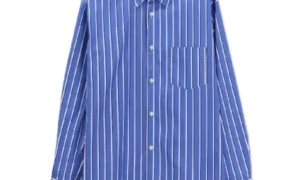Step into the world of cartilage charm and discover the stylish allure of earrings that add a touch of sophistication to your look. Cartilage earrings have become increasingly popular in recent years, offering a unique way to express your personal style and enhance your overall aesthetic. Whether you’re a seasoned piercing enthusiast or considering getting your first cartilage piercing, this blog post will guide you through everything you need to know about this trendy trend. From understanding different types of cartilage piercings to caring for them properly, we’ll delve into all aspects so that you can confidently rock your cartilage earrings with flair! So let’s dive in and explore the captivating realm of cartilage charm together!
What is Cartilage Charm and Why is it Popular?
Cartilage charm refers to the art of adorning your cartilage with elegant and fashionable earrings. Unlike traditional lobe piercings, which are done on the fleshy part of the earlobe, cartilage piercings involve puncturing the tougher tissue of the upper ear. This creates a distinct and edgy look that has gained immense popularity in recent years.
One reason for the growing popularity of cartilage charm is its versatility. With various types of cartilage piercings available, such as helix, tragus, conch, and daith piercings, there’s no shortage of options to choose from. Each piercing offers a unique placement opportunity for showcasing different earring styles.
Aside from their aesthetic appeal, cartilage earrings are also favored due to their ability to transform any outfit effortlessly. Whether you’re dressing up for a special occasion or going for a more casual look, adding an eye-catching piece of jewelry to your cartilage instantly elevates your style game.
Moreover, getting a cartilage piercing allows you to express your individuality and showcase your personal taste in jewelry. From delicate studs and hoops to elaborate dangles adorned with gemstones or charms, there’s something for everyone when it comes to decorating your cartilage.
This surge in popularity can be attributed not only to the uniqueness and versatility offered by these charming pieces but also because they provide individuals with an opportunity for self-expression through creative styling choices. So if you’re looking to add some flair and pizzazz to your overall appearance while embracing this trendy trend – it’s time you explore the captivating world of cartilage charm!
Types of Cartilage Piercings
When it comes to cartilage piercings and Flat back earrings, there are a variety of options to choose from. Each type offers its own unique charm and can be customized to suit your personal style. Let’s explore some popular types of cartilage piercings!
1. Helix Piercing: This is the most common type of cartilage piercing, located on the outer rim of the ear. It allows for endless possibilities in terms of jewelry selection, including studs, hoops, and dainty earrings.
2. Tragus Piercing: Situated on the small flap just in front of the ear canal, this piercing adds a touch of edginess to any look. From delicate gemstones to bold statement pieces, tragus piercings offer versatility in earring choices.
3. Daith Piercing: Positioned in the innermost fold of cartilage above the ear canal, daith piercings have gained popularity not only for their aesthetic appeal but also for their potential therapeutic benefits with migraine relief.
4. Rook Piercing: Located on the antihelix ridge inside the upper part of the ear, rook piercings create an interesting visual effect when adorned with unique earring designs such as curved barbells or captive bead rings.
5. Conch Piercing: Found at two different areas – inner conch (center) and outer conch (upper edge) – these piercings offer ample space for larger statement earrings or even multiple stud combinations.
Remember that every individual’s anatomy may vary slightly; therefore, it’s essential to consult with a professional piercer who can guide you through selecting an appropriate placement based on your specific preferences and comfort level.
Now that we’ve explored some popular types of cartilage piercings let’s move onto discussing important factors to consider before getting one! Stay tuned!
Factors to Consider Before Getting a Cartilage Piercing
Factors to Consider Before Getting a Cartilage Piercing
Getting a cartilage piercing can be an exciting and trendy way to express your personal style. However, before you take the plunge, there are a few important factors to consider.
It’s crucial to think about the pain factor. Unlike getting your ears lobes pierced, cartilage piercings tend to be more painful due to the thickness of the cartilage tissue. This may not be a deterrent for everyone, but it’s definitely something worth considering if you have a low tolerance for pain.
Another factor is healing time. Cartilage piercings generally take longer to heal compared to regular earlobe piercings. Depending on where exactly you want your piercing and how well you care for it afterwards, healing can range from several months up to a year.
Additionally, think about potential complications or risks associated with cartilage piercings. These include infection, keloids (raised scar tissue), and even damage or loss of hearing if the piercing is done improperly near certain areas of the ear.
Consider whether you’re willing and able to commit to proper aftercare for your new piercing. This involves cleaning it regularly with saline solution or mild soap, avoiding touching it with dirty hands, and refraining from swimming in pools or bodies of water until fully healed.
By carefully contemplating these factors beforehand, you’ll be better equipped to make an informed decision about whether or not getting a cartilage piercing is right for you!
Caring for Your Cartilage Piercing
Caring for your cartilage piercing is crucial to ensure proper healing and prevent infections. Here are some essential tips to keep in mind:
1. Cleanse gently: Use a saline solution or mild soap and warm water to clean your piercing twice a day. Avoid using alcohol-based products as they can be too harsh and irritate the delicate skin.
2. Be mindful of touching: Resist the temptation to constantly touch or twist your earring, as this can introduce bacteria into the piercing site. Only handle it when necessary, and always make sure your hands are clean.
3. Avoid sleeping on it: Sleeping on your side can put pressure on the piercing, causing discomfort and prolonging healing time. Try sleeping on your back or investing in a travel pillow that allows for better positioning.
4. Steer clear of irritants: Keep hairspray, perfume, and other chemicals away from your piercing as they can cause irritation or even allergic reactions.
5. Patience is key: Remember that cartilage piercings take longer to heal compared to earlobe piercings – sometimes up to a year! Don’t rush changing jewelry; wait until you’re confident in its stability before switching things up.
By following these care tips diligently, you’ll give yourself the best chance at beautiful, healed cartilage charm!
The Trendy World of Cartilage Earrings
The world of cartilage earrings is a playground for fashion lovers who want to add some edge and style to their look. These tiny accessories have become a trendy way to express individuality and create unique ear piercings. From delicate studs to bold hoops, there is a wide range of cartilage earrings available that can be mixed and matched for endless possibilities.
One popular choice in the trendy world of cartilage earrings are helix piercings. This type of piercing is done on the upper part of the ear, creating a stylish statement piece. Helix cuffs, dainty studs, and elegant hoops are just some options you can explore with this particular piercing.
Another sought-after trend in cartilage earrings is the tragus piercing. Located right above the ear canal, this area offers a perfect spot for small stud or hoop earring placement. With its unique positioning, tragus piercings allow for eye-catching designs that can instantly elevate your style.
For those looking to make an even bolder statement, industrial piercings might be worth considering. This type of piercing involves connecting two separate holes with a long barbell earring across the top portion of the ear. The result is an edgy and attention-grabbing look that stands out from traditional earring styles.
When it comes to choosing your cartilage earrings, there are several factors worth considering: size, material quality (such as sterling silver or hypoallergenic metals), comfort level during healing process etc.
It’s also important not to rush into getting multiple piercings at once – start with one or two initially until you’re comfortable with them before adding more.
While DIY methods may seem tempting when it comes to changing your cartilage earrings at home,
it’s advisable
to seek professional help for initial piercings.
This ensures proper hygiene and reduces risks associated with improper techniques.
However,
once healed,
you can experiment
with different styles
and change your cartilage earrings yourself – just remember to clean everything properly beforehand.
DIY vs Professional: Which Option is Best for You?
When it comes to getting a cartilage piercing, you may be wondering whether to go the DIY route or seek the help of a professional. Both options have their pros and cons, so let’s explore them further.
DIY piercings can be tempting because they offer convenience and cost savings. With just a needle and some basic tools, you can create your own unique look. However, it’s important to remember that cartilage is delicate and requires precision when piercing. Without proper knowledge and experience, there is an increased risk of infection or damage to the cartilage.
On the other hand, opting for a professional piercer ensures that your cartilage piercing is done safely and correctly. They have the expertise to sterilize equipment effectively and minimize any potential risks. Plus, professionals can provide guidance on jewelry selection, placement options, and aftercare tips tailored specifically for your needs.
Before making a decision, consider factors such as your pain tolerance level, comfort with handling needles or jewelry tools on yourself (if going the DIY route), budget constraints, and desired outcome of your piercing experience.
Remember that no matter which option you choose – DIY or professional – proper care is crucial in maintaining a healthy healing process for your new cartilage earring. Always follow aftercare instructions provided by professionals or reputable sources to prevent infections or complications.
Only you can decide which option is best for you based on your personal preferences and circumstances. If in doubt about performing a safe procedure at home or if this would be your first time getting pierced altogether – it’s always wise seeking advice from an experienced professional who will ensure both safety & beauty!
Final Thoughts and Tips for Rocking Your Cartilage Earrings
Final Thoughts and Tips for Rocking Your Cartilage Earrings
Now that you know all about cartilage charm and the different types of piercings available, it’s time to dive into the world of stylish cartilage earrings. Whether you opt for hoops, studs, or dangles, there are plenty of options to choose from that will enhance your personal style and make a statement.
Here are some final thoughts and tips to help you rock your cartilage earrings with confidence:
1. Start small: If you’re new to cartilage piercings, it’s best to start with a smaller earring before moving on to larger designs. This will give your piercing time to heal properly and prevent any unnecessary discomfort.
2. Choose high-quality materials: When selecting cartilage earrings, be sure to choose high-quality materials such as surgical-grade stainless steel or titanium. These materials are hypoallergenic and less likely to cause irritation or infection.
3. Experiment with different styles: Don’t be afraid to experiment with different styles of cartilage earrings! Mix and match hoops with studs or try out unique shapes like crescents or stars. The possibilities are endless!
4. Keep it clean: Proper aftercare is essential for maintaining healthy piercings. Cleanse the area regularly using saline solution or a mild soap specifically designed for piercings.
5. Avoid sleeping on your piercing: It’s important not to sleep directly on your newly pierced ear as this can cause irritation and prolong healing time. Consider investing in a travel pillow or sleeping on your back until fully healed.
6. Be patient during the healing process: Healing times vary depending on the individual but can take anywhere from several weeks up to several months for complete healing. It’s crucial not to rush the process by changing jewelry too soon.
7. Take care when styling hair: Be mindful when styling your hair around freshly pierced cartilage as getting snagged can lead to discomfort and potential complications. Tie back long hair or use a gentle touch when brushing.





























































